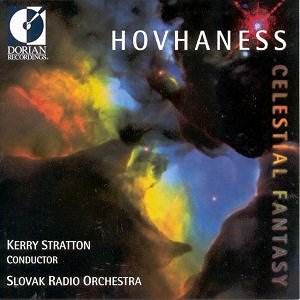Aside from being rather short on playing time for a
CD (an ‘offence’ exacerbated by the acreage of unrecorded Hovhaness
that could have been added) this is an extremely good collection. These
are predominantly early works (seven of the five are from the 1940s)
and the disc is recommendable to the curious and to the nervous explorer.
In some of his symphonies (and also in Mountains and Rivers Without
End) Hovhaness can push the envelope and challenge those who might
have difficulties with Ligeti, Stockhausen or Cage. There is some grit
in this collection. For example in The Holy City. This affords
a succinct essay in Hovhaness technique with its episodes of slowly
slaloming violin melisma (exactly as in the almost contemporaneous concert
overture Fra Angelico), cantorial trumpet solos and Tallis
Fantasia meditations for the strings.
The Alleluia and Fugue must surely have influenced
Arnold Rosner (well worth exploring on Albany) in its blend of oriental
and with hints of the much later Vaughan Williams’ Concerto Grosso
for strings. Processional and Fugue (these bipartite titles
recall one of Creston’s accustomed formats) has a distinctly Armenian
sway with hints of temple dances and in the more ecstatic expressive
moments pointing towards the contemporaneous Tippett Concerto for
Double String Orchestra. Processional and Fugue has an undulant
role for the oratorical trumpet and is both florid and incisive in the
fugue with a most unusual (for Hovhaness) chasseur horn call.
Celestial Fantasy is the earliest piece. It
must have been one of the few saved from the bonfire of his allegedly
Sibelian vanities. Middle Eastern ululation meets gravely reflective
music. Along the way there are moments which may remind well travelled
listeners of Vaughan Williams’ Dives and Lazarus Variants and
Shostakovich’s Razliv movement. The austere Third Rhapsody
ascends into a dervish-whirl, bright with hysteria and sharp as
a scimitar. In Memory of an Artist is a tribute to Sarah Berman
with a murmurous mid-range violin melody offset by pizzicato. The superbly
joyous string writing will appeal to those who like Warlock (Capriol)
and Moeran (Serenade). The adagio writing is particularly warm.
Among these comforting episodes you also encounter a furiously buzzing
stridulation. The Psalm and Fugue offers a warm cocoon of string
sound. Nothing strident appears. This music is closest to Finzi yet
offers a more passionately torrential swell.
The designers and builders of this fine concert hall
must also take a bow alongside the engineers and orchestra. I have already
remarked on this superb acoustic in reviews of the symphonies of Alexander
Moyzes (Marco Polo). It is lively, delivering both power, transparency
and warmth. If you have a concert hall to design go to the team who
produced this one. The orchestra sounds full-bodied in this hall.
Decent English only liner notes are by Steven Lowe.
There is no direct comparison. Of course there are
other good compilations on Telarc and on Crystal. This is perhaps a
softer edged introduction than some although it is by no means bland.
Spirituality is its strong suit as are the performance and recording
values. If you enjoy this then by all means move on to the Crystal CDs
of the Majnun and St Vartan symphonies.
Rob Barnett
